How to Make Meringue: The Ultimate Guide
All of my best tips for how to make the perfect meringue, with a basic recipe, step-by-step instructions, a video, and tons of advice and troubleshooting tips to ensure your meringue whips up glossy, stiff, and beautiful each and every time!
If you’ve ever wondered, what is meringue? And how in the world can I make it?! You’ve come to the right place!
Meringue intimidates many home cooks, but I’m here to unravel the mystery and give you the confidence to grab your egg whites and start whipping the next time you see it in a recipe. You will be making it like a pro in no time!
You’ve undoubtedly heard of lemon meringue pie, but what else is meringue used for? So many things! It can top other pies and puddings, be baked to create cookies or pavlova, or mixed with butter to create some of the most luscious, silky smooth frostings you’ve ever tasted.
Meringue begins with egg whites and sugar and is transformed into billowy white clouds of pure deliciousness.
Let’s tackle it together!
Ingredients for meringue
- Eggs – Fresh eggs are best for making meringue. Using boxed or carton egg whites is not recommended, as they are usually pasteurized, and that processing can sometimes keep the meringue from getting completely glossy and stiff.
- Sugar – Can’t have a meringue without the sweetness of sugar!
- Cream of tartar – Meringue’s secret ingredient! It creates a strong, stable meringue.
- Salt + Vanilla – Flavor, flavor, flavor!
The importance of cream of tartar
This little ingredient is so important, it deserves its own section here.
Cream of tartar is an acid that stabilizes the egg whites and is what gives you those big, beautiful, billowy pillows of fluffy white meringue. To get science-y on you, it keeps the proteins from the egg whites from sticking together, which ensures a super-smooth meringue that will not wilt or deflate on itself.
How much? The general rule of thumb is to use ⅛ teaspoon for every egg white in the recipe.
Substitute: If you are out of cream of tartar and don’t have time to get to the store, you can substitute ½ teaspoon lemon juice (another acid!) for every egg white in the recipe.
Step-by-step instructions
Meringue is a fairly simple process; by following the directions and using the tips outlined below, you will be a meringue master! Here’s how we make it:
- Beat the egg whites using a mixer on medium speed (or by hand) until they are broken up and frothy.
- Add the cream of tartar, salt, and vanilla extract.
- Beat to soft peaks on medium-high speed.
- Gradually add the sugar, a couple of tablespoons at a time, until it has all been incorporated.
- Continue beating until glossy, stiff peaks form. At this point, you can’t overbeat the meringue, so keep beating until you’ve got those glossy, firm peaks!
Different types of meringue
There are three main types of meringue; while they all combine egg whites and sugar in some way, the techniques used are different, as are the applications. Let’s discuss:
French Meringue – This is the type we’re talking about today! Also known as “uncooked” meringue, it’s simply the whipping together of egg whites and sugar until peaks form; it is typically used to top pies and make meringue cookies and pavlovas and is always baked in some way after preparing.
Swiss Meringue – To make this meringue, the egg whites and sugar are heated together to a specific temperature (I always heat to 160 degrees F so it is safe to eat), ensuring the sugar has dissolved, and then mixed until room temperature, and whipped until stiff peaks form. To turn this into Swiss meringue buttercream frosting, once you have stiff peaks and the mixture is no longer warm, add butter a piece at a time, and whip until it is light, fluffy, and silky smooth. A perfect topping for cakes and cupcakes!
Italian Meringue – Italian meringue is made with hot sugar syrup. Egg whites are whipped to soft peaks in a mixer, then the sugar syrup that has been boiled to “soft ball” stage is gradually poured in while the mixer is running, then the mixture whipped until it has cooled to room temperature. Since the sugar is cooked and added to the egg whites, it is safe to eat without baking, so is perfect for recipes that use meringue toppings that are not baked, or merely torched. It is the most stable of all the meringues, holds its shape very well, and can also be turned into Italian meringue buttercream frosting with the addition of butter!
Recipe tips and troubleshooting
Follow these tips for amazing, picture-perfect meringue every single time:
- Use room temperature eggs – Separating eggs is easiest when they are cold, but then let the egg whites come to room temperature (about 30 minutes) before making the meringue; this ensures they whip up with maximum volume.
- Use a clean bowl and utensils – Even the slightest hint of fat (egg yolk, residual oil on a bowl or beaters, etc.) can prevent the egg whites from reaching stiff peaks. Ensure that everything is completely clean and dry before beginning.
- Gradually add the sugar – It’s important to add the sugar only a little bit at a time (a couple of tablespoons); adding it slowly ensures that the sugar gets absorbed into the egg whites and eliminates a gritty texture, and also reduces the chances of the meringue collapsing and failing to reach stiff peaks (this can happen if a lot of sugar is added all at once).
- You can’t overbeat meringue – It’s true! You can’t ruin it by mixing too much, so once all of the sugar is added, be sure that it is glossy and that you have super firm, stiff peaks when you remove the beater from the mixer. Don’t be afraid to mix a little longer if it appears too soft.
- Adding colors/flavors – If you want to add different flavors, you should do so when the vanilla extract is added. To make a colored meringue, add food coloring (I recommend gel food coloring to eliminate extra liquid being introduced into the recipe) once the meringue has reached stiff peaks, and beat until the color is completely incorporated.
- Recommended equipment: The easiest way to make meringue is with a stand mixer (hands-free!), but I routinely make it with my trusty hand mixer. You can also make it by hand, just use a large wire whisk and some elbow grease! It will take a little longer, but it can be done!
- Check the weather: Meringue is notoriously sticky and difficult to whip into stiff peaks on humid days. While central heating and cooling eliminate most problems, I do notice a difference when I work with it or bread dough (my grandma used to say the same about her pizzelles!) on a dry winter day vs a warm summer day, even with central air. To keep issues at bay, opt for a day with low humidity.
What to make with meringue:
- Pavlova: Try a classic pavlova, a pavlova layer cake, or even a chocolate pavlova!
- Cookies: Make a batch of chocolate chip meringue cookies.
- Pie: Lemon meringue pie is a classic, but you can top any citrus-y or even cream pie with meringue!
- Pudding: Classic southern-style banana pudding is topped with a gorgeous meringue.
If you make this recipe and love it, I would so appreciate it if you would take a moment to leave a rating below. Thank you so much! ❤️️
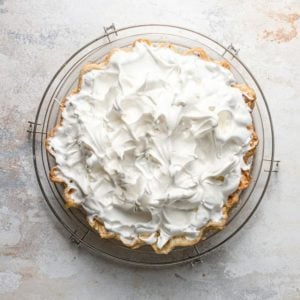
Basic Meringue Recipe
Ingredients
- 5 egg whites
- ½ teaspoon cream of tartar
- ½ teaspoon vanilla extract
- Pinch salt
- ½ cup (99 g) granulated sugar
Instructions
- Using an electric mixer with the whisk attachment (or a hand mixer), beat the egg whites on medium speed until frothy, then add the cream of tartar, salt, and vanilla extract.
- Increase the mixer speed to medium-high and beat to soft peaks. While continuing to beat the egg whites, gradually add the granulated sugar and beat until glossy and stiff peaks form.
Notes
- Eggs - Use room temperature eggs. Egg whites from a box or carton are not recommended.
- Clean bowl and utensils - Even the slightest hint of fat (egg yolk, residual oil on a bowl or beaters, etc.) can prevent the egg whites from reaching stiff peaks. Ensure that everything is completely clean and dry before beginning.
- Gradually add the sugar - It's important to add the sugar only a little bit at a time (a couple of tablespoons); adding it slowly ensures that the sugar gets absorbed into the egg whites and eliminates a gritty texture, and also reduces the chances of the meringue collapsing and failing to reach stiff peaks (this can happen if a lot of sugar is added all at once).
- You can't overbeat meringue - It's true! You can't ruin it by mixing too much, so once all of the sugar is added, be sure that your meringue is glossy and that you have super firm, stiff peaks when you remove the beater from the mixer. Don't be afraid to mix a little longer if it appears too soft.
- Adding colors/flavors - If you want to add different flavors, you should do so when the vanilla extract is added. To make a colored meringue, add food coloring (I recommend gel food coloring to eliminate extra liquid being introduced into the meringue) once the meringue has reached stiff peaks, and beat until the color is completely incorporated.
- Equipment: The easiest way to make meringue is with a stand mixer (hands-free!), but I routinely make it with my trusty hand mixer. You can also make it by hand, just use a large wire whisk and some elbow grease! It will take a little longer, but it can be done!
- Weather: Meringue is notoriously sticky and difficult to whip into stiff peaks on humid days. While central heating and cooling eliminate most problems, I do notice a difference when I work with meringue or bread dough on a dry winter day vs a warm summer day, even with central air. To keep issues at bay, opt for a day with low humidity.
- Recipes using meringue: For tons of ideas, see the links in the post above.
Did you make this recipe?
Leave a review below, then snap a picture and tag @thebrowneyedbaker on Instagram so I can see it!
[Photography by Dee of One Sarcastic Baker]


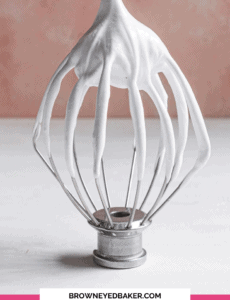
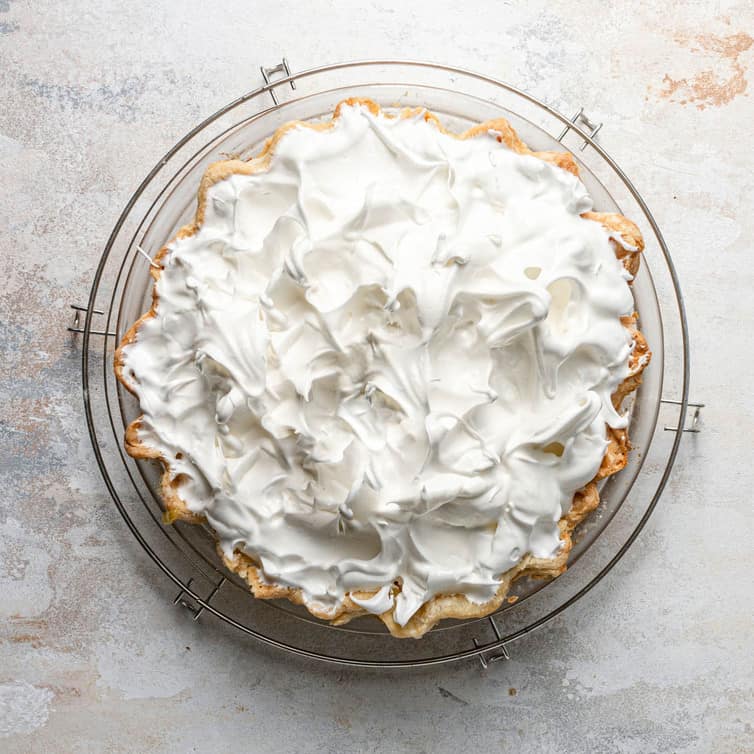
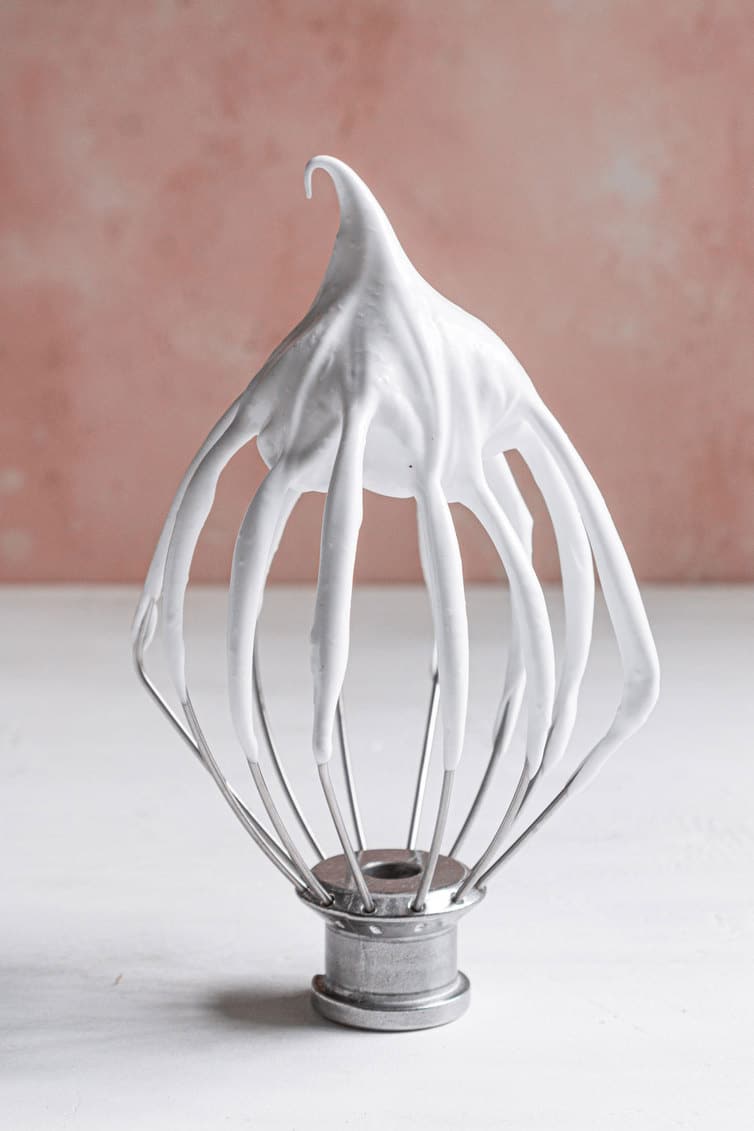
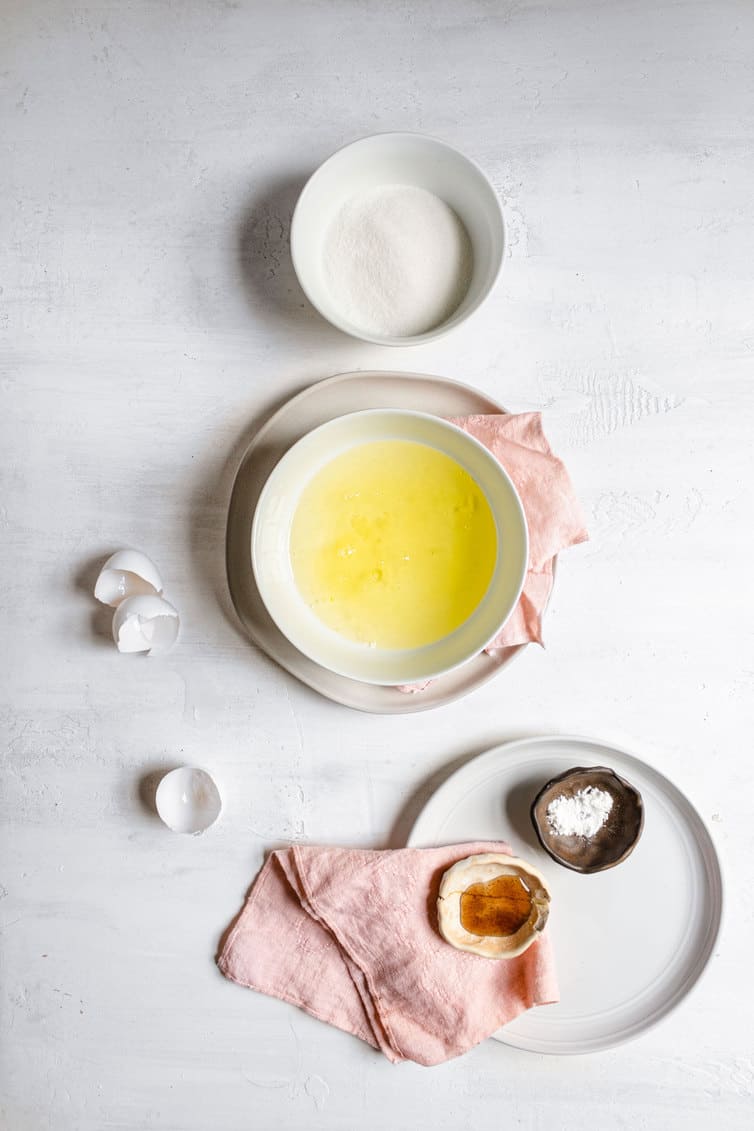
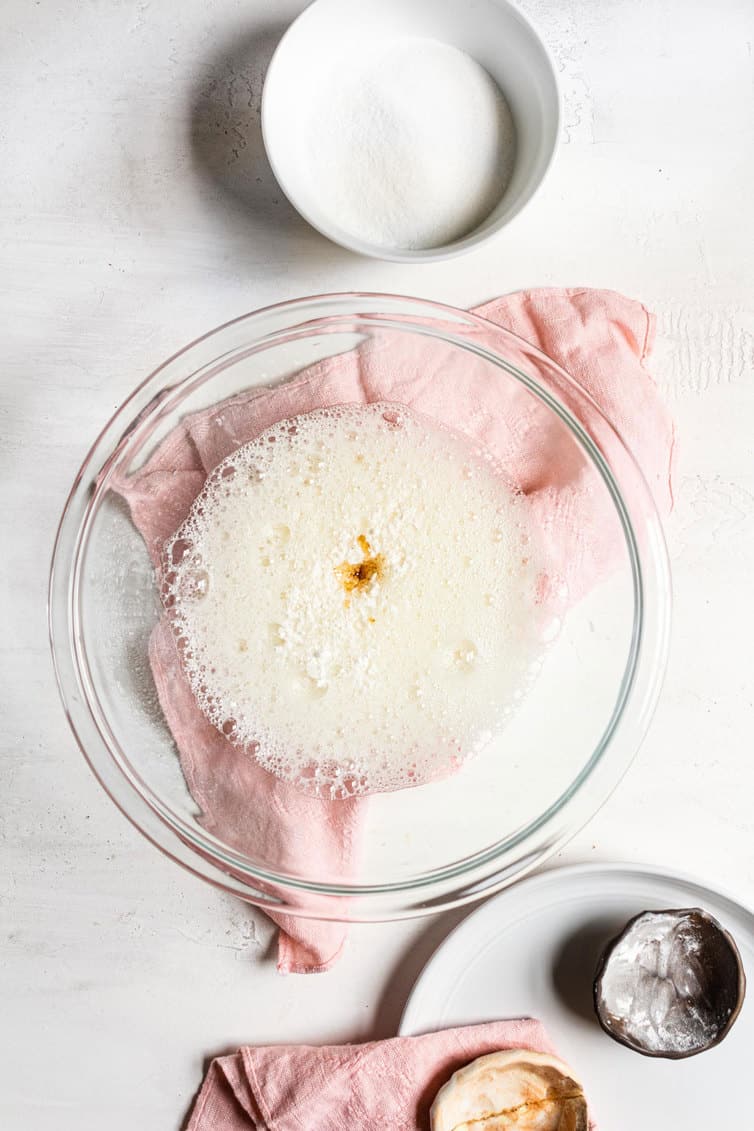
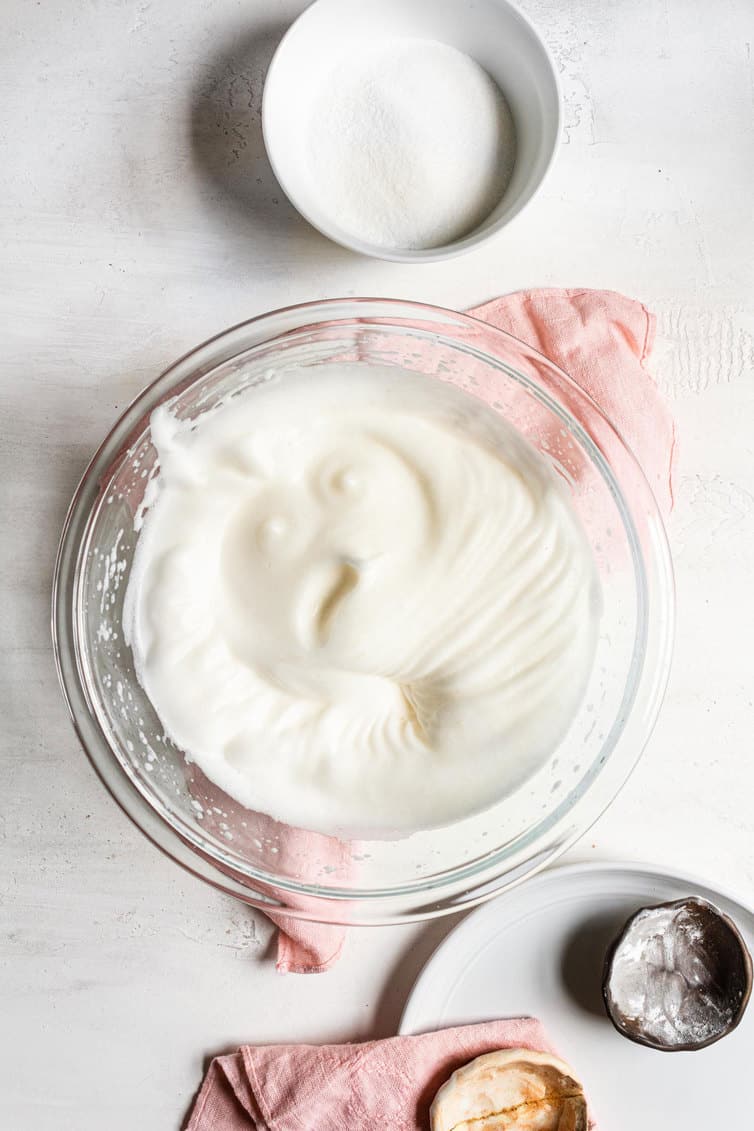
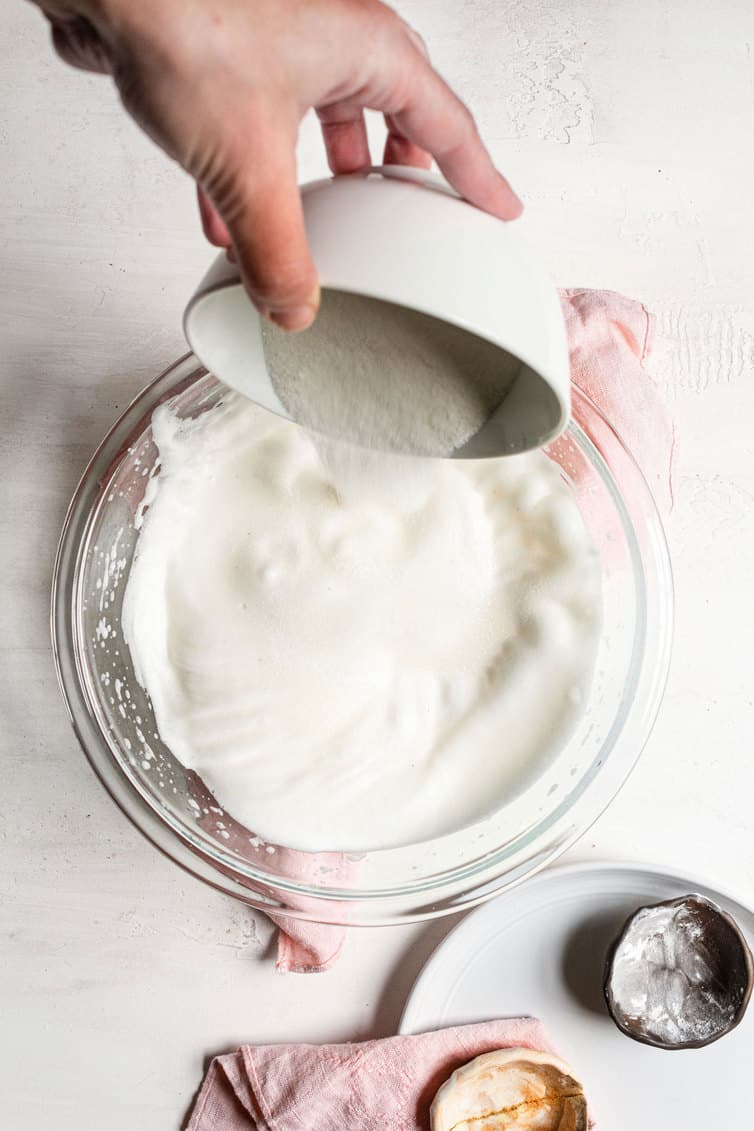
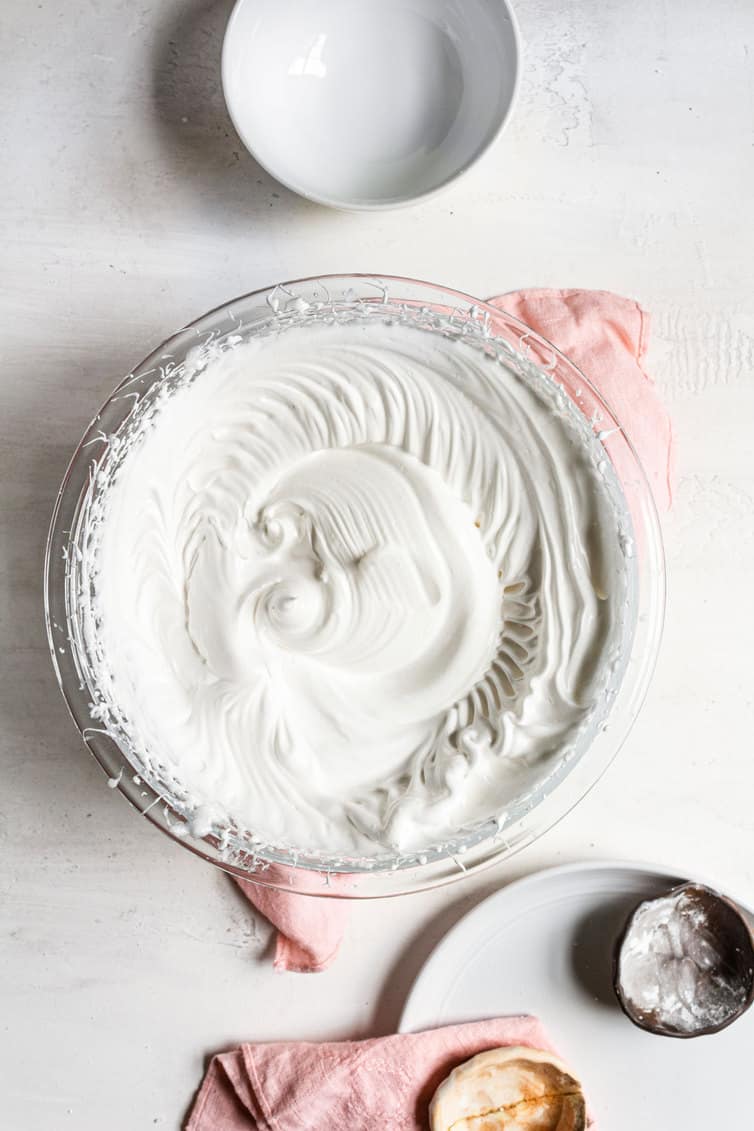
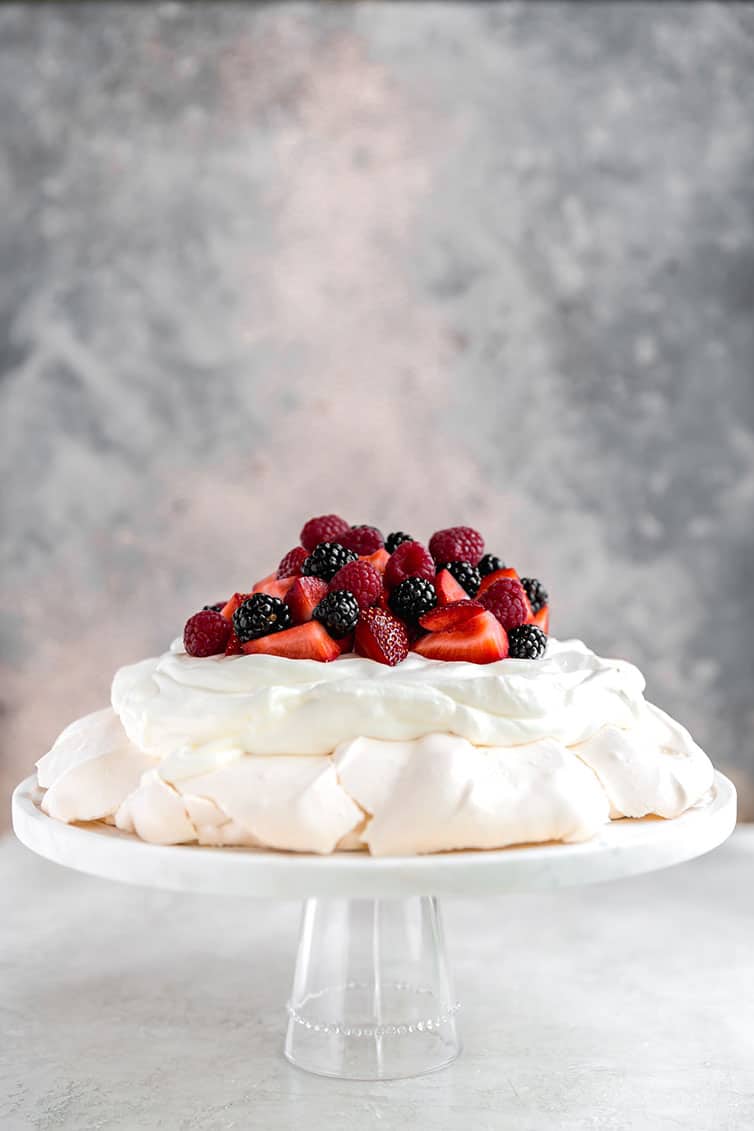
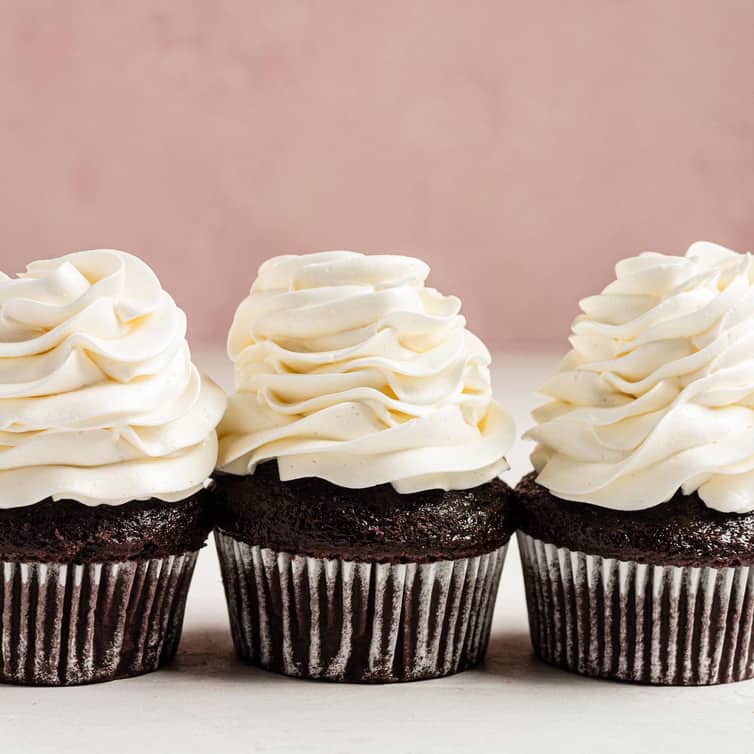
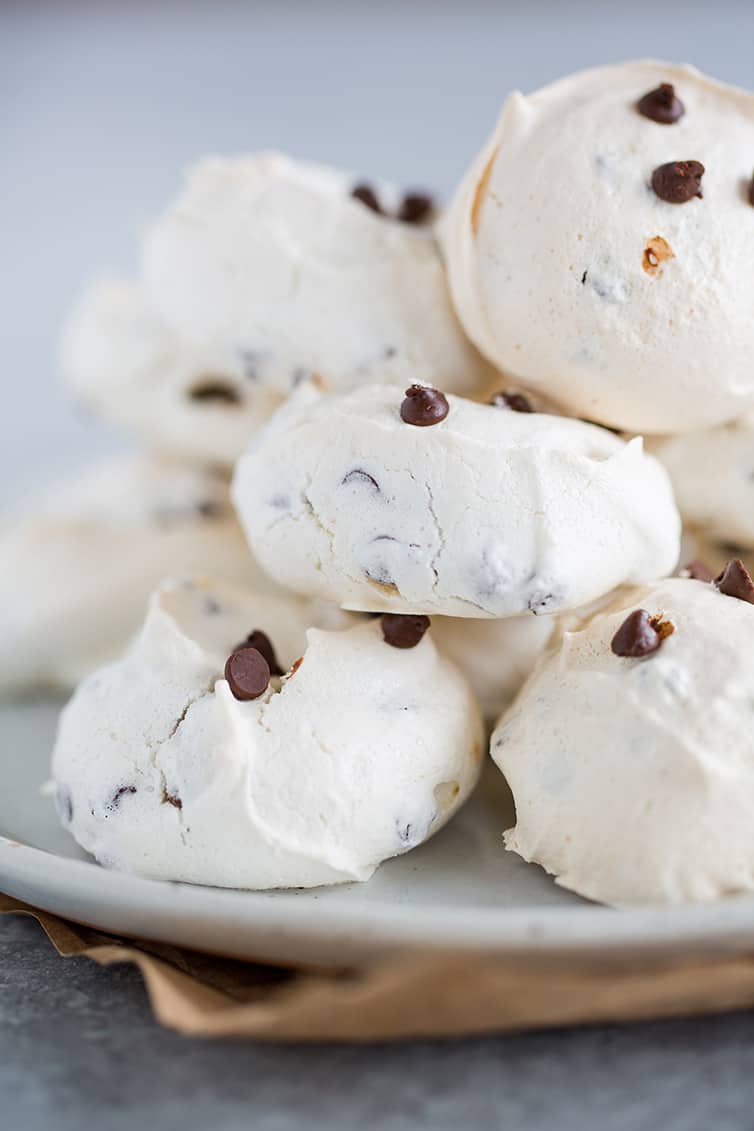



Mmmmm good!
Why leave out the temperature of the oven to bake, and how long. I would think this would be very important for the recipe
I agree. I made a beautiful meringue, but had no clue how long to bake it and at what temp. Had to guess. Went to google and the only advice I found was “low and slow”. Not real helpful.
I have a question regarding amounts of cream of tartar. In your article you say to use ⅛ teaspoon for every egg white. But in your recipe you gave 5 egg whites but only ½ teaspoon of cream of tartar. Shouldn’t it be 1½ teaspoons for 5 egg whites? I think my math is right, but hasn’t always been a strong point. Thanks – Robert
Hi Robert, ⅛ = 0.125… 0.125 * 5 (egg whites) = 0.625, which is a little more than ½, a little less than ⅓, so I rounded down to ½ teaspoon for ease of measurement.
No instructions on oven temp.
Your whole article on meringue was a God send it’s truly nice of you to supply so much information about the different meringues and butter frosting conversions. Honestly, I’m prepared to beat my egg whites and I love your writer or screen name of course I’m a brown eyed someone as well. Again, thank you and I’m a new fan and follower. Shannon Doss, RN. Blessed to be.
This is such an easy recipe and the tips were extremely helpful. Thank you!!
This was easy! Thank you!
YOU DO NOT PUT AT WHAT TEMPERATURE THE OVEN AND FOR HOW LONG SHOULD I COOK THEM!!!!!!!!!!SHAME ON YOU……..
Petfect!
I did not have the cream of tartar, so I Googled the alternative. It turns out that an equal amount of lemon juice is the substitute. The meringue turned out beautifully.
Thank you for the tips! I made a meringue twice yesterday for a pie and they both failures. It was a hot humid day in Mississippi.
Thanks for the tips.
How do you adjust this to high altitude?
I hope you can help me. For years my mom would make her homemade cake and meringue icing. It wasn’t fancy or anything, just a simple homemade cake with homemade icing. I would write down her simple recipes because I knew she wouldn’t be around forever. I managed to get most of the recipes she cooked or baked but I forgot to ask her about her meringue icing before she passed away 2 years ago. I can remember her just using 3 ingredients, the ingredients she used were egg whites, I can’t remember how many she used, 1 cup sugar and 1 teaspoon vanilla. How many egg whites do I use and like I said this was just a simple homemade icing, nothing fancy and nothing added but the 3 ingredients I mentioned. I loved her icing.
Chef Michelle:
Your technical instructions were flawless with exceptional results! Thank you teaching an old chef a new trick!
Stay healthy and safe,
God bless,
Joy
Great explanation Thanks
You could have said the temperature and about how long . Everything else is a go and sounds like my mothers. If I can send picture of my pudding.
fantastic recipe Never let us down! Thanks for posting, we used vinegar instead of cream of tartar and it still turned out perfectly! spider solitaire 2 suit
My granddaughter and I made our first cake together, the meringue came out great we will always use this recipe. Thank you!
Even though no times or over temp. I just made this for a lemon pie. Kept in oven for 5 to 10min at 350 bc I was baking other things. Just checked in during that time so the peaks didn’t burn! Came out great!
It doesn’t tell what temperature to cook the meringue.
Looks awesome… worth a try
I am a beginner with meringue. I made a pavlova and it did turn out great. The recipe I used listed caster sugar, which I understand is powdered regular white sugar. I have made this sugar before. I assume that it mixes more thoroughly? Does it really make a difference to use or not?
This came out of the oven and was beautiful! Problem was later when it cooled, I picked it up and very slightly tilted it and it poured liquid off from under the meringue (It was on a chocolate pie). I am sure it was something I did wrong but I have no idea what it was.
Same thing happened to me! Would appreciate any tips as to why and how to prevent it. We still ate it but it didn’t look nice.
Everything is so detailed and well explained thank you so much for this! I do have a question
I tried making meringue in the past, I never baked it I always used it as a topping but when I stored it; it always separates, a clear liquid would split from the egg whites
Do you know why this is? I assume it’s because my recipe lacked cream of tartar/acidity but I’m not too sure
I am going to try this recipe soon and see if it solves my issue but I figured asking the pros for help
Thank you!
The Southern Banana Pudding recipe is great. The only thing that is different from what I grew up with is that Mom always made two layers of wafers, bananas and pudding and then the meringue. Otherwise, just like Momma used to make.
Perfecto!
Super recipe! Never fails us! We were out of cream of tarter and used vinegar and it was still perfect🥰 thanks for posting!!
Perfect every time….thankx for tips.I did have to use limes once instead of tartar.still came out great..🙂
Your meringue details are very easy to follow but you have not given times or oven temperatures and that’s what I struggle with mostly.
Thank you excellent recipe for meringue pie. I added cream, strawberries and kiwis. Very tasty.
I’m learning how to make the meringue on pies.
What temp for the meringue?
I looking forward to using this meringue recipe to make a Ritz Nut Torte. My previous attempts have failed.
Nice one. I can’t wait to try it out. Thanks for sharing ❤️
Have not tried it yet.I will try later.thanks
HELP!!! My meringue weep from underneath where it make contact with my pie filling. EVERY TIME. I use a stand mixer until my egg whites form stiff peaks. What am I doing wrong?
Lisa I feel your pain. I have tried at least 20 different recipes and they all look wonderful and taste great but they all have that watery sugary liquid running out of them. Makes me sick to my stomach after I have tried so hard.
It’s interesting that nothing said about his how to “dry” the meringues…
I usually make them in a dehydrator.
I have tried a number of meringue recipes and by far this is the best ever!
Fantastic
Thats how 8 make mine. X
Thanks for the recipe
It would be nice if there was an oven temperature recommended!
It really depends on what you are making! If you are making pavlova or meringue cookies, then the temperature will be super low (2oo to 250 degrees); if you are making meringue to top a pie or banana pudding, then the temperature will be higher (usually around 325 to 350). Always check the recipe that you are using for a temp and time.
Unfortunately, it turns out hat you CAN overbeat meringue. My meringue came out dry and lumpy, which I have now read means that it’s been overwhipped. Hopefully it will turn out better next time!
I made the meringue. The recipe did not say what temperature to bake. So, I used 350 as a starting point. Perfect baked meringue on my pie!!!
Do you have tips for making meringue at high altitudes? My 87 year old mother had to move from the valley to a high altitude. Her specialty is lemon meringue pie <3
Hi Karen, Generally you want to beat the egg whites to soft peaks instead of stiff. It will allow for more expansion when baked at high altitude. I hope this helps! Let me know how her pie turns out :)
What makes the meringue fall after you have baked it. It doesn’t stay high and lofty.
Hi Boni, Are you talking about on a pie or something like a pavlova?
I can not find the Oven Temperature and Baking time?
Hi Cindy, It depends on what you’re making. In the post above, I’ve linked to a number of recipes that use this meringue. It will different if you’re using it for a pavlova, meringue-topped pie, etc. If you have a recipe, follow those baking instructions, or try one of the recipes above. Enjoy!
Hands down, the best meringue I’ve ever made. Excellent instructions and tips!
I’m so thrilled to hear this!
Thank you.
First attempt a delicious success. I used this recipe as a guide.
What I wanted to do, and did, was boil the canned juices of 0 (zero) added sugar products for peaches and pears. That became my sugary goodness to blend into the beaten egg whites.
I used the lemon substitute too. It’s all so yummy. Can’t wait to add this to my peaches and pear pie…. aha, it’s ready!
50 years meringue I was NEVER SUCCESSFUL — your tips are WONDERFUL — THANK you !!
You are so welcome!! :)
Hi I am making these RIGHT NOW! I don’t know how they will turn out I followed the steps carefully. They are baking (I just put them in the oven) in the oven and Are not cooking but I will check in a few minutes. OMG these are so good! I love them but they are pretty dry. But you should make these for sure! just make sure NOT to over mix them it kinda ruins it.
I bakes these at 323 *F for 15 min
Thank you so much. You saved the day. I think I love you lol
It would be nice to know what temperature to bake the meringue
Michelle,
You say you’re using the French meringue in this recipe and describe the Swiss and Italian meringues. Is there a reason you used the French? Could the Swiss or Italian have been used? Is it just a personal preference or is one better than another? How does one know which meringue to use?
Thanks!
dee
Thanks for the recipe. Previously, meringues did not work, but when I did it step by step according to your recipe, everything worked out the first time. And finally I was able to try Pavlova.
Thanks for the short and informative article!
Brilliant recipe! I’ve never tried making meringue using cream of tartar before, but this definitely helped. I also never realised that the egg whites needed to be at room temperature. I used this recipe to make little meringue nests. Came out brilliantly crispy on the outside, and lovely and soft inside. Quick question though – Ialways find that my meringues come out quite yellow (not the nice white colour you see in see in photographs)
I baked these at 250 degrees for an hour and half. Any idea why this is?
Hi Ruth, I’m so glad you liked the recipe! As for your yellow color, that can happen when the sugar in the meringue caramelizes and tints the meringue during baking. The remedy is to lower the oven temperature or baking time. For making meringue nests, I usually see an oven temperature of 200 degrees, so I would try that next time and see if it helps you get whiter baked meringue :)
HI Michelle,
I don’t make meringues as I have problems with the egg whites, so I don’t eat eggs, but this is a great tutorial. You’ve gone into detail so it’s easy to follow and ONE DAY, I will try my hand at a recipe and surprise the family with a great meringue topping. Thanks. Keep well and stay safe.
I am not a big fan of Meringue so I usually fold it into my Lemon Pie filling for Lemon Chiffon Pie love that. I have not tried the Italian Meringue but that is on my to do list of things to try. Love your recipes and watching your kids grow up. Keep up the good work.
Thank you, Barbara!
I haven’t made it yet, but with your excellent directions, I know that I won’t have any problems. I like your recipes because they are so well explained and I never have a problem understanding how to make them. Thank you.
You’re welcome, Peggy! I’m so happy to hear that you’ve found the recipes helpful and useful, xo
Do you have much trouble with separating or weeping meringue? I read that sugar granule size can be a factor, hot filling, cold filling…..
Hi Penny! There a couple of keys to keep the meringue from weeping – the first is to be sure to spread it up against the pie crust and make sure it’s touching the whole way around – this sort of “seals” it. The second is that I always have heard to spread fresh meringue on a warm filling, then bake. It helps them to adhere to one another, which reduces the likelihood of weeping. My lemon meringue pie recipe (https://www.browneyedbaker.com/daring-bakers-lemon-meringue-pie/) goes into a bit more detail, but I hope that helps!
You didn’t include anything about browning the meringue. Which is better, low oven for a long time or hot oven quickly? I always brown the meringue on Lemon pie, coconut cream pie, banana pudding, etc.
Hi Beth, It all depends on what you are using the meringue recipe for – topping a pie, making pavlova, meringue nests, meringue cookies, etc. If you’re talking about the topping for a pie or banana pudding, I would go 325 for about 20 minutes. I hope that helps!
My grandma and now my mom make the meringue with chocolate chip cookies. We call them Go To Bed cookies because my grandma would turn the oven off and then them cool down as the oven cooled. I recently saw an episode of Molly Yeh on Food Network and she heated the sugar on a cookie sheet before adding it to the whipped egg whites. It had something to do with the stability of the meringue. So interesting.